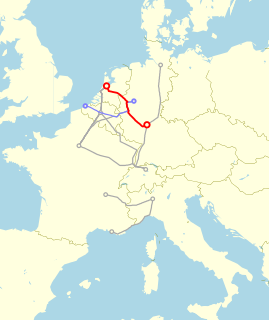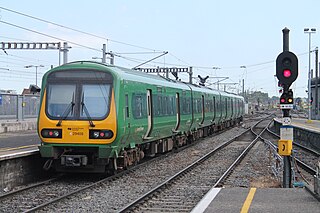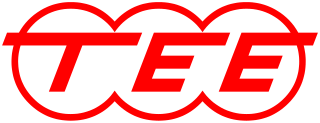
The Albert Schweitzer was a short-lived express train that linked Dortmund Hbf in Dortmund, Germany, with Strasbourg-Ville in Strasbourg, France. Introduced in 1980, it was operated by the Deutsche Bundesbahn (DB) and the SNCF.

The word Mediolanum has been used to name three distinct international express trains that have run to and from Milano Centrale in Milan, Italy since 1957. The focus of these trains on the city now known as Milan reflects the fact that Mediolanum is the Latin word for ancient Milan.

The Catalan Talgo was an international express train introduced in 1969 that linked Geneva, Switzerland, with Barcelona, Spain. It was named after the Spanish region Catalonia and the Talgo equipment it used. It was an extension and upgrading of a predecessor train, Le Catalan, a first-class-only French (SNCF) Rapide train that had been in operation since 1955 but running only between Geneva and the stations nearest the Spanish-French border, connecting with a second-class-only "autorail" trainset to and from Barcelona. The national railway network of Spain, Red Nacional de los Ferrocarriles Españoles (RENFE), was using Iberian gauge for all of its main lines, while those of France and Switzerland use standard gauge. As a result of this break-of-gauge, train journeys between Geneva and Barcelona consisted of two separate parts, with travelers having to change from a French to a Spanish train or vice versa at the border—at Portbou on southbound trains and at Cerbère on northbound trains. In 1968, this was resolved with the introduction of the Talgo III RD trainsets, which featured variable gauge wheelsets. At Portbou station, the wheel spacing of each passenger carriage was adjusted by a gauge changer for the difference in gauge, and passengers no longer had to change trains. After successful test runs, the Catalan was extended from Port Bou to Barcelona as a through train on 1 June 1969, becoming the Catalan Talgo and upgraded to a Trans Europ Express (TEE). Most other rail journeys through this border crossing continued to require a change of train at Cerbère station or at Port Bou, as most trains did not use Talgo III RD trainsets.

The Blauer Enzian is a named express train service that currently runs between Frankfurt in Germany and Klagenfurt in Austria. Introduced in 1951, it originally ran via the German North–South railway line between Hamburg and Munich. Labelled as an international Trans Europ Express (TEE) train, it also linked with Zell am See and Klagenfurt in Austria from 1969. Trains were operated by the Deutsche Bundesbahn (DB) and its Deutsche Bahn successor, from 1970 also by the Austrian Federal Railways (ÖBB).
The Diamant was an express train operated by the Deutsche Bundesbahn (DB), using different routes over the years. The name Diamant, Flemish for diamond, refers to the city of Antwerp, which is the European centre of diamond trade and has a diamond district. The initial service started in 1962 as a first-class-only FernTriebwagen linking the West-German capital Bonn with Antwerp, using a class DB Class VT 08 diesel multiple unit (DMU).

The Saphir was an express train operated by the Deutsche Bundesbahn linking the port of Ostend with Dortmund as part of a link between London and the Ruhr. The name Saphir, German for sapphire, refers to the Belgian gemstone industry.
The Lemano was an international express train linking Milan with Geneva. The train is named after Lake Geneva, the north shore of which was followed by the train over the lake's entire length. Introduced in 1958, it was a first-class-only Trans Europ Express service until 1982, and thereafter a two-class express train.

L'Oiseau Bleu was an international express train linking Antwerp with Paris. The train was named after the play L'Oiseau Bleu as a tribute to its author, the Belgian Nobel prize laureate Maurice Maeterlinck.

The Ticino was an express train that linked Milan in Italy, with Zürich, Switzerland and for some years even to Munich, Germany. The train was named after the Canton of Ticino in the south of Switzerland. Introduced in 1961, it was a first-class-only Trans Europ Express (TEE) service until 1974. Later, it was a EuroCity service.

The Rhein–Main was an express train that linked Frankfurt am Main with Dortmund in Germany and later with Amsterdam in the Netherlands. The train was named after the two rivers, the Rhine and the Main, that join west of Frankfurt. For most of its life, it was a Trans Europ Express (TEE).

The Rembrandt was an express train that linked Amsterdam in the Netherlands, with Munich in Germany and later Chur in Switzerland. The train was named after the renowned Dutch painter Rembrandt. For its first 16 years it was a first-class-only Trans Europ Express, becoming a two-class InterCity in 1983 and finally a EuroCity in 1987.
The Bacchus was an express train in Germany, initially linking Dortmund and Munich. The train was named after the Roman God of wine, although for most of its existence it linked two cities famous for producing beer.
The Friedrich Schiller was an express train in Germany, initially linking Düsseldorf and Stuttgart. The train was named after the philosopher and playwright Friedrich Schiller.

The Lufthansa Airport Express was an express train service in Germany, initially linking Düsseldorf and Frankfurt am Main Flughafen, and later Stuttgart too. The trains were operated by Deutsche Bundesbahn on behalf of the German airline Lufthansa, and with the airline providing the on-board customer service staff, and its use was limited to Lufthansa customers taking airplane flights into or out of Frankfurt or Düsseldorf airports.

The Gambrinus was an express train in Germany, initially linking Munich and Kiel. The train was named after the God of Beer Gambrinus.
The Heinrich Heine was an express train operated by Deutsche Bundesbahn, initially linking Frankfurt am Main and Dortmund. The train was named after the German poet and journalist Heinrich Heine.

The Adriatico was an express train operated by Ferrovie dello Stato, linking Milan and Bari. It was named for the Adriatic Sea, Mare Adriatico in Italian, as the train's route served the main cities along the shore of the Adriatic between Rimini and Bari.

The Molière was an international train operated by SNCF, initially linking Paris and Düsseldorf. The train was named after Jean Baptiste Poquelin using his stage name.



























